The costs of kitchen cabinets depend on several factors that influence their price and overall value. Materials like solid wood or MDF play a significant role in determining the durability and appearance of kitchen cabinets. Construction methods, such as framed or frameless designs, also affect the cost of kitchen cabinets. Custom features, including pull-out shelves or decorative elements, increase complexity and labor requirements for kitchen cabinets. Geographic location and craftsmanship quality further impact the pricing of kitchen cabinets. Homeowners should evaluate these factors carefully to align their choices with their budget while ensuring functionality and style in their kitchen cabinets.
Kitchen cabinet prices depend on materials, how they're made, and features.
Stock cabinets cost the least and are great for quick fixes.
Semi-custom cabinets let you design more but cost a bit more.
Custom cabinets fit special spaces but are pricey and take longer.
Materials matter; solid wood is strong but costs morhttps://html-cleaner.com/#e. MDF and plywood are cheaper.
Painted finishes cost more than stained ones because they take more work.
Hiring pros to install is precise, but DIY saves money if done right.
Check market trends and seasons to buy at the best time.
The choice of cabinet materials significantly influences the cost, durability, and appearance of kitchen cabinets. Homeowners often weigh options like solid wood, plywood, and MDF to find the right balance between budget and functionality. Each material offers unique benefits and drawbacks, making it essential to understand their characteristics before making a decision.
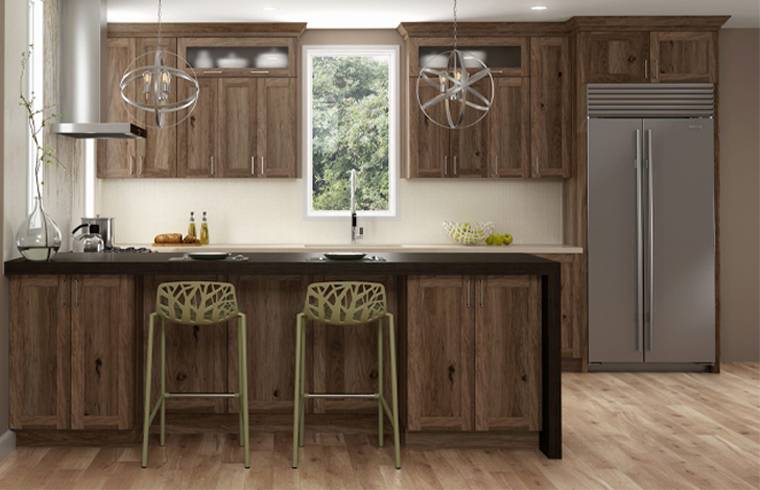
Solid wood is a premium material known for its natural beauty and durability. It is often used in custom kitchen cabinets due to its ability to withstand wear and tear over time. This material can endure environmental changes, although it may warp or crack with significant moisture fluctuations. Regular maintenance, such as polishing and sealing, helps preserve its appearance and longevity.
While solid wood cabinets come with a higher price tag, they offer excellent value in the long run. They enhance the overall aesthetic of a kitchen and can increase a home's resale value. Compared to plywood, solid wood is more expensive but justifies its cost with superior strength and timeless appeal. Homeowners seeking high-quality custom cabinets often prioritize solid wood for its unmatched durability and elegance.
Plywood is a versatile and cost-effective alternative to solid wood. It consists of thin layers of wood veneer glued together, creating a strong and stable material. Plywood resists warping and cracking better than solid wood, making it a reliable choice for kitchen cabinets. Its affordability makes it an attractive option for homeowners on a budget.
Although plywood is less expensive than solid wood, it still offers excellent durability. It can handle daily use and withstand moderate environmental changes. Many semi-custom cabinets use plywood for their construction, providing a balance between quality and cost. For those looking to save money without compromising on strength, plywood is a practical choice.
MDF is an engineered material made from wood fibers and resin. It is a popular choice for budget-friendly cabinets due to its smooth surface and affordability. MDF resists warping and cracking, making it suitable for painted finishes. However, it is less durable than solid wood and plywood, especially in areas prone to moisture exposure.
To maintain MDF cabinets, homeowners must ensure proper sealing to prevent water damage. While MDF lacks the strength of solid wood, it offers a modern aesthetic at a lower cost. Many stock cabinets use MDF for their construction, providing an economical option for quick renovations. For those prioritizing affordability and style, MDF is a viable choice.
Material | Durability Characteristics | Maintenance Needs |
MDF | Resistant to warping and cracking; susceptible to water damage; lower strength than wood. | Requires sealing to prevent moisture damage |
Solid Wood | Strong and durable; prone to scratches and dents; can warp with moisture fluctuations. | Requires regular maintenance to prevent damage |
Choosing the right cabinet materials depends on individual needs and budget. Solid wood offers timeless quality, plywood provides a cost-effective balance, and MDF delivers affordability with a sleek finish. Understanding these options helps homeowners make informed decisions when selecting materials for their kitchen cabinets.
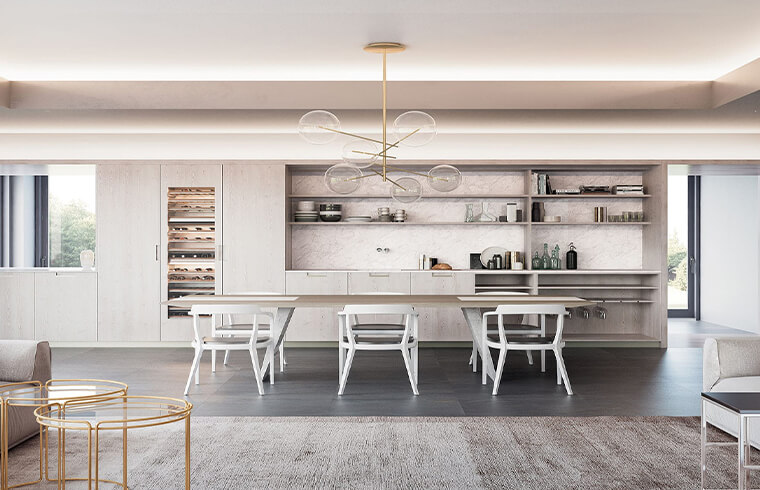
Laminate and thermofoil are popular cabinet materials that offer affordability and versatility. These options cater to homeowners seeking stylish yet budget-friendly solutions for their kitchen cabinets.
Laminate consists of multiple layers of paper or fabric bonded with resin under high pressure. This process creates a durable and smooth surface that resists scratches and stains. Laminate cabinets come in a wide range of colors, patterns, and textures, including options that mimic natural wood or stone. This variety allows homeowners to achieve their desired aesthetic without exceeding their budget. However, laminate may chip or peel over time, especially in high-traffic areas. Proper care, such as avoiding excessive moisture and heat, can extend its lifespan.
Thermofoil, on the other hand, is a vinyl material applied to medium-density fiberboard (MDF) using heat and pressure. This process results in a seamless and easy-to-clean surface. Thermofoil cabinets are available in various finishes, including glossy, matte, and woodgrain styles. They are resistant to stains and fading, making them a practical choice for busy households. However, thermofoil is less heat-resistant than laminate and may warp or discolor when exposed to high temperatures. Installing heat shields near ovens or stoves can help prevent damage.
Both laminate and thermofoil are cost-effective alternatives to solid wood or plywood. Laminate cabinets typically cost between $50 and $200 per linear foot, while thermofoil cabinets range from $100 to $300. These materials provide an excellent balance of affordability and style, making them ideal for homeowners with limited budgets.
Note: Laminate and thermofoil cabinets are best suited for kitchens with moderate use. Homeowners should consider their durability and maintenance needs when selecting these cabinet materials.
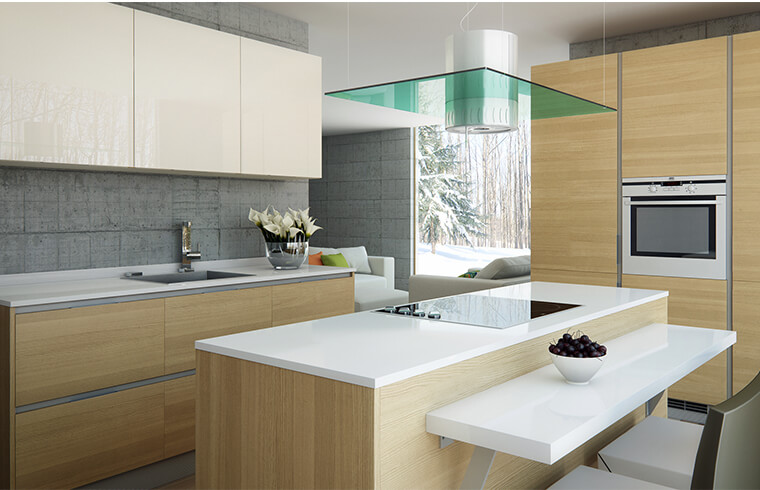
The style of a kitchen plays a significant role in determining cabinet costs. Different kitchen aesthetics require specific materials, finishes, and design elements, all of which contribute to pricing. Whether you prefer a sleek modern kitchen or a timeless traditional design, understanding how these styles impact costs can help you make informed decisions.
Modern kitchens are characterized by their clean lines, minimalist aesthetic, and innovative materials. Cabinets in these kitchens often feature frameless designs for a seamless look, as well as high-gloss or matte finishes that enhance their sleek appearance. Materials such as laminate, thermofoil, and acrylic are commonly used due to their smooth surfaces and contemporary appeal.
The cost of modern kitchen cabinets depends on the quality of materials and finishes. High-gloss acrylic and matte lacquer finishes tend to be more expensive due to their sophisticated look and durability. Frameless cabinets, which require precise craftsmanship and high-quality hardware, also increase overall costs. However, the lack of ornate detailing and simpler construction can make modern cabinets more cost-effective than highly decorative styles.
Traditional kitchens emphasize craftsmanship, intricate detailing, and classic design elements. Cabinets in these kitchens often feature raised panel doors, crown molding, decorative corbels, and custom millwork. The preferred materials for traditional cabinets include solid wood, plywood, and high-end veneers, ensuring durability and an elegant finish.
Due to the intricate detailing and high-quality materials, traditional kitchen cabinets are generally more expensive than modern styles. The use of solid wood, custom carvings, and specialty stains or glazes can significantly increase costs. Additionally, traditional cabinets often require professional installation to ensure precision in alignment and detailing, further adding to the overall expense.
Farmhouse and rustic kitchens embrace a warm, inviting, and vintage-inspired aesthetic, often incorporating distressed finishes, natural wood grains, and open shelving. Cabinet materials typically include reclaimed wood, stained oak, or distressed pine, which enhance the rustic charm. Shaker-style or beadboard cabinets are commonly used in these designs, offering a balance between simplicity and texture.
The pricing of farmhouse and rustic cabinets varies based on the choice of materials and finishes. Reclaimed wood and hand-distressed finishes can be expensive due to the labor-intensive process of aging the wood. However, stock shaker cabinets with a simple stain or distressed paint finish provide a more budget-friendly alternative while maintaining the rustic charm.
Minimalist kitchens focus on simplicity, functionality, and seamless design. Cabinets in these kitchens typically feature flat-panel doors, handleless push-to-open mechanisms, and neutral color palettes. High-end materials such as lacquered MDF, acrylic, and metal finishes are popular choices for achieving a streamlined aesthetic.
Minimalist cabinet designs often come with higher costs due to premium finishes and advanced hardware. Push-to-open systems, integrated LED lighting, and hidden storage solutions increase both material and installation costs. Additionally, minimalist kitchens often require custom cabinetry to maintain clean, uninterrupted lines, making them more expensive than stock or semi-custom options.
Luxury kitchens represent the pinnacle of customization, craftsmanship, and premium materials. These kitchens feature fully custom cabinetry, often made from exotic woods, high-end veneers, or premium lacquer finishes. Additional features such as soft-close drawers, integrated appliances, and gold or brass hardware elevate both aesthetics and functionality.
Due to the high level of personalization and superior materials, luxury kitchen cabinets come with a premium price tag. Each cabinet is typically custom-built to fit the space perfectly, requiring skilled craftsmanship and longer lead times. Additionally, luxury kitchens often include specialty storage solutions, glass-front display cabinets, and intricate detailing, all of which contribute to increased costs.
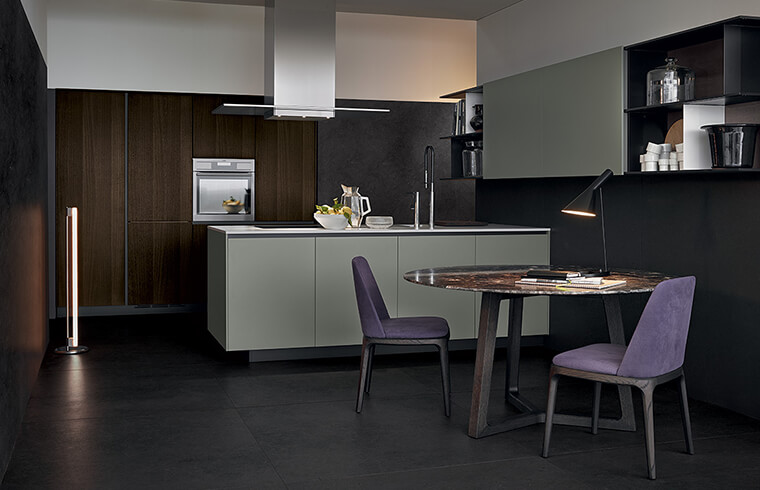
The finish applied to kitchen cabinets plays a significant role in their appearance, durability, and cost. Homeowners can choose from a variety of finish options, each offering unique benefits and price points. Understanding these options helps in selecting the right balance of aesthetics and functionality.
Painted and stained finishes are among the most popular choices for kitchen cabinets. Each offers distinct advantages and impacts the overall cost differently. Painted cabinets provide a smooth, modern look and are available in a wide range of colors. However, the labor-intensive process of applying paint makes these cabinets 10-15% more expensive than stained ones.
Stained finishes, on the other hand, highlight the natural beauty of wood. They are more durable than painted finishes and easier to touch up if scratches or wear occur. Stained cabinets also tend to be more cost-effective, making them a practical choice for homeowners seeking a balance between aesthetics and budget.
Tip: Painted finishes work well for contemporary kitchens, while stained finishes complement traditional or rustic designs.
Finish Type | Advantages | Disadvantages |
Painted | Wide color range; smooth appearance | Higher cost; prone to chipping |
Stained | Highlights wood grain; durable | Limited color options; less modern look |
Specialty finishes elevate the look of kitchen cabinets while offering varying levels of durability and maintenance requirements. Options like semi-gloss, gloss, lacquer, and shellac provide unique aesthetic qualities. Semi-gloss finishes, for example, resist heat, scratches, and water, making them ideal for busy kitchens. Gloss finishes, such as lacquer, enhance the natural beauty of wood and are easy to clean.
However, specialty finishes often require professional application to achieve the best results. They can also increase the overall cost of custom cabinets due to the additional labor and materials involved. While these finishes add character and charm, they may demand extra maintenance to preserve their appearance over time.
Advantages | Disadvantages |
Extensive color range | Can crack or peel if not maintained |
Camouflages imperfections | Requires professional application for best results |
Adds a luxurious or seamless look | May not suit all kitchen styles |
Note: Specialty finishes like lacquer or shellac are ideal for homeowners seeking a high-end, polished look for their custom kitchen cabinets.
The choice of hardware significantly influences both the functionality and price of kitchen cabinets. Premium options, such as soft-close hinges and designer handles, enhance usability and aesthetics. Accessories like pull-out drawers and lazy Susans improve storage efficiency but add to the overall cost.
Hardware prices vary widely, ranging from $1.50 knobs to $75 designer handles. An average kitchen requires about 75 pieces of hardware, meaning the total cost can quickly escalate depending on the selections. High-quality hardware not only elevates the kitchen's overall feel but also ensures long-term durability.
Tip: Investing in durable hardware can save money on replacements and repairs in the future.
Built-in storage solutions improve the functionality of kitchen cabinets by maximizing space and organization. Features like pull-out shelves, lazy Susans, and spice racks allow homeowners to access items easily while keeping the kitchen tidy. These additions are particularly useful in smaller kitchens where efficient use of space is essential.
Pull-out shelves, for example, eliminate the need to reach into deep cabinets, making them a practical choice for storing pots, pans, or pantry items. Lazy Susans optimize corner cabinets by providing a rotating platform for easy access to stored goods. Spice racks, often integrated into cabinet doors, keep spices organized and within reach during cooking. While these features enhance convenience, they also increase the overall cost of cabinets due to the additional materials and labor required for installation.
Tip: Homeowners should prioritize built-in storage solutions that align with their cooking habits and storage needs to ensure a functional and cost-effective kitchen design.
Decorative elements add character and style to kitchen cabinets, transforming them into focal points of the kitchen. These features include intricately carved door panels, crown molding, and decorative side panels. While they enhance the aesthetic appeal, they also raise the cost of cabinets due to the craftsmanship and materials involved.
Sophisticated designs, such as bespoke storage solutions or carved panels, require skilled labor and additional resources, increasing costs.
Cabinet trim add-ons, like crown molding, can raise the price by 5% to 25%, depending on the complexity of the design.
Specialty finishes, such as distressed or antiqued styles, add depth and character but demand expert application, further impacting the budget.
For homeowners seeking cost-effective decorative options, simpler styles like flat-front doors or Shaker designs offer a modern look without high expenses. Accessories, such as knobs and pulls, also provide an affordable way to enhance cabinet aesthetics.
<table cellspacing="0" width="448" margin: 0 auto">
Element Type | Description | Cost Implication |
Stained Cabinets | Resistant to moisture and warping, offering longevity at a lower investment. | Lower than painted finishes |
Flat-Front Doors | Simpler design, typically more affordable. | More cost-effective than intricate stylesPrivacy |
Shaker/Slab Front | Contemporary styles that provide a modern look without high costs. | Budget-friendly option |
Accessories | Enhances functionality and aesthetics, ranging from $50 to $500. | Provides increased utility and organization |
Note: Decorative elements should align with the overall kitchen style and budget to achieve a cohesive and visually appealing design.
Unique layouts and sizes allow homeowners to tailor their kitchen cabinets to fit unconventional spaces or specific needs. Custom cabinets excel in this area, offering flexibility in dimensions, shapes, and configurations. For instance, cabinets designed for sloped ceilings or narrow spaces ensure no area goes unused.
Custom layouts also accommodate specialized appliances or unique kitchen designs. Tall pantry cabinets, for example, provide ample storage for bulk items, while under-sink cabinets with cutouts for plumbing maximize utility in tight spaces. These tailored solutions require precise measurements and skilled craftsmanship, which increases the cost compared to standard-sized cabinets.
Tip: Homeowners should consider unique layouts and sizes when standard cabinets fail to meet their spatial or functional requirements.
The cost of installing kitchen cabinets depends on whether homeowners choose professional services or opt for a DIY approach. Each option has its own set of advantages, challenges, and cost implications. Understanding these factors helps homeowners make an informed decision that aligns with their budget and skill level.
Professional installation ensures precision and high-quality results. Skilled installers handle every aspect of the process, from measuring and aligning cabinets to securing them in place. This expertise minimizes the risk of errors, ensuring the cabinets function properly and last longer.
The cost of professional installation varies based on factors like cabinet type, project complexity, and location. On average, professionals charge between $40 and $80 per hour or $50 to $450 per linear foot. For larger projects, total costs can range from $2,000 to $50,000. Urban areas, such as New York or Los Angeles, often have higher labor rates due to elevated living expenses and greater demand for skilled trades. In rural areas, labor costs tend to be lower, though contractors may charge additional travel fees if they come from nearby cities.
Tip: Hiring professionals is ideal for complex installations or when homeowners want to ensure a polished, long-lasting finish.
While professional installation offers convenience and craftsmanship, it requires a significant financial investment. Homeowners should weigh the benefits of professional expertise against their budget constraints to determine if this option suits their needs.
DIY installation appeals to homeowners looking to save money. By handling the installation themselves, they can avoid labor costs, which often make up a significant portion of the overall expense. This approach is particularly attractive for those with prior experience or a willingness to learn.
However, DIY installation comes with risks. Mistakes during assembly or installation can lead to structural issues, misaligned cabinets, or even damage to walls and floors. These errors may require costly repairs, negating the initial savings. Common challenges include insufficient space for cabinet delivery, misalignment of electrical or plumbing systems, and a lack of proper tools or workspace.
Note: Homeowners should consider their skill level, available time, and the complexity of the project before committing to a DIY approach.
While DIY installation can reduce costs, it demands careful planning and execution. For those with limited experience, consulting a professional or seeking guidance can help avoid costly mistakes.
Comparison: Professional installation guarantees quality but comes at a higher cost, while DIY installation offers savings but requires skill and effort. Homeowners should evaluate their priorities to choose the best option for their kitchen renovation.
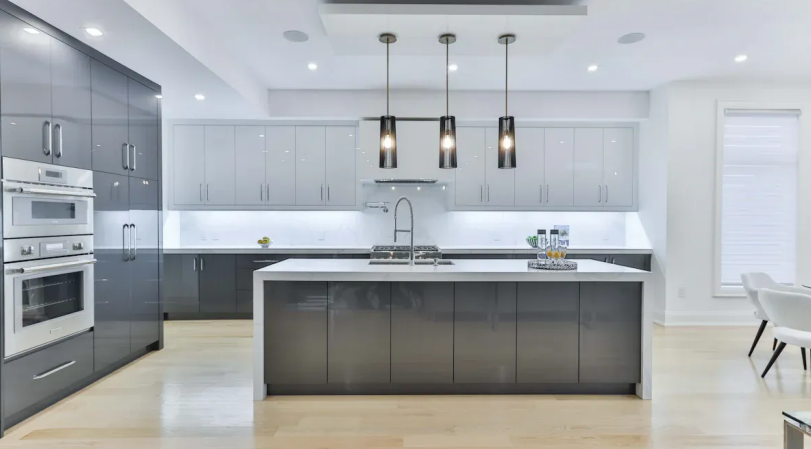
The brand and manufacturer of kitchen cabinets significantly influence their price and quality. Different brands cater to varying budgets and preferences, offering a range of features and materials.
High-end cabinet brands often provide superior drawer options, ensuring better durability and functionality. However, upgrading drawers in mid-range brands can achieve similar longevity.
Frameless cabinet brands, such as IKEA and Poggenpohl, are popular for their sleek, modern designs. Framed cabinet brands, like Kraftmaid, may require additional upgrades to match the quality of frameless options.
Consumer satisfaction ratings can sometimes be misleading. These ratings often reflect initial impressions rather than long-term performance, making it essential to research thoroughly before purchasing.
Choosing a reputable brand ensures better craftsmanship and durability, but it also increases the overall cost. Homeowners should evaluate their priorities and budget to find a balance between affordability and quality.
Tip: Researching customer reviews and comparing features across brands can help homeowners make informed decisions.
Geographic location plays a crucial role in determining kitchen cabinet costs. Labor rates, material availability, and local demand vary across regions, directly impacting the final price. Urban areas often have higher labor costs due to elevated living expenses and greater demand for skilled workers. In contrast, rural areas may offer lower labor rates, though additional travel fees might apply if contractors come from nearby cities.
Market conditions also affect cabinet pricing. Fluctuations in raw material availability, such as wood and hardware, can disrupt production and increase costs. Rising fuel prices and logistical challenges lead to higher shipping expenses, further driving up prices. Additionally, production delays caused by supply chain disruptions can extend project timelines, adding to labor costs.
Note: Homeowners in areas with high demand or limited resources should plan their projects carefully to avoid unexpected expenses.
The project timeline directly influences the cost of kitchen cabinet installation. Replacing cabinets typically takes two and a half to three weeks, while more complex projects may extend to four or five weeks. Longer timelines often result in higher labor costs, as contractors charge for additional hours or days of work.
Cabinet installation can account for 30–50% of the total renovation budget. Delays in the timeline may lead to increased expenses, including extended labor charges and potential storage fees for materials. Homeowners should consider these factors when planning their renovation to avoid exceeding their budget.
Tip: Setting a realistic timeline and coordinating with contractors can help minimize delays and keep costs under control.
Market conditions play a significant role in determining the cost of kitchen cabinets. These conditions include factors such as supply chain disruptions, material shortages, and economic trends. Understanding how these elements affect pricing helps homeowners plan their budgets more effectively.
Supply chain disruptions often lead to increased cabinet prices. Delays in the transportation of raw materials, such as wood or hardware, can slow down production. Manufacturers may pass these additional costs to consumers. For example, a shortage of high-quality plywood might force companies to source materials from distant suppliers, increasing shipping expenses.
Tip: Homeowners can avoid price spikes by purchasing cabinets during periods of stable supply.
Material shortages also impact cabinet pricing. Limited availability of popular materials, like solid wood or thermofoil, can drive up costs. When demand exceeds supply, manufacturers may prioritize higher-paying orders, leaving budget-conscious buyers with fewer options. This situation often occurs during peak renovation seasons, such as spring and summer.
Material | Impact of Shortage | Result |
Solid Wood | Increased demand for premium materials | Higher prices for custom cabinets |
Thermofoil | Limited production due to resin shortages | Fewer affordable options available |
Economic trends, such as inflation or changes in consumer spending, also influence cabinet costs. Rising inflation increases the price of raw materials, labor, and transportation. Conversely, during economic downturns, manufacturers may lower prices to attract more customers. Monitoring these trends can help homeowners decide the best time to invest in kitchen cabinets.
Note: Economic conditions vary by region. Researching local market trends can provide valuable insights into pricing fluctuations.
Seasonal demand affects the availability and cost of kitchen cabinets. During peak renovation periods, manufacturers and contractors experience higher workloads. This increased demand often results in longer lead times and higher labor costs. Off-season purchases, such as during winter, may offer better deals and faster delivery.
Tip: Planning a renovation during the off-season can save money and reduce wait times.
Market conditions constantly evolve, impacting the cost and availability of kitchen cabinets. Homeowners who stay informed about these factors can make smarter purchasing decisions and optimize their renovation budgets.
Kitchen cabinet costs depend on various factors, including materials, finishes, and customization options. Homeowners should allocate 30%-35% of their kitchen remodeling budget to cabinets, focusing on essential features like durable hardware and built-in storage. Investing in high-quality custom kitchen cabinets enhances the kitchen's value and design, making it appealing to potential buyers. Durable cabinets also reduce maintenance costs over time, offering long-term benefits. To ensure functionality, homeowners can maximize storage with adjustable dividers or door-mounted organizers. Thoughtful cost-relevant decisions during a kitchen remodel lead to a practical and stylish space that meets both needs and budget.
Stock cabinets are the most affordable option. They are pre-manufactured and come in standard sizes with limited design choices. Prices typically range from $60 to $200 per linear foot, making them ideal for budget-conscious homeowners.
Material choice significantly impacts cost. Solid wood is the most expensive due to its durability and natural beauty. Plywood offers a balance of quality and affordability, while MDF and laminate provide budget-friendly alternatives with modern aesthetics.
Custom cabinets offer tailored designs, superior craftsmanship, and the ability to fit unique spaces. They are worth the investment for homeowners prioritizing quality and personalization. However, they come with higher costs and longer lead times.
Professional installation increases costs but ensures precision and durability. Installers charge between $40 and $80 per hour or $50 to $450 per linear foot. This option minimizes errors and guarantees a polished finish.
DIY installation can save money by eliminating labor costs. However, it requires skill and proper tools. Mistakes during installation may lead to costly repairs, negating the initial savings.
Painted finishes cost 10-15% more than stained ones due to labor intensity. Specialty finishes, like lacquer or gloss, add elegance but increase costs. Homeowners should choose finishes that align with their budget and kitchen style.
Labor rates, material availability, and demand vary by region. Urban areas often have higher costs due to elevated living expenses. Rural areas may offer lower rates but could include additional travel fees for contractors.
Off-season periods, such as winter, often provide better deals and faster delivery. Seasonal demand during spring and summer increases prices and lead times. Planning purchases during stable market conditions can also help avoid price spikes.
Tip: Researching brands, materials, and market trends ensures better decisions and cost savings.
We employ cookies to analyze website traffic and enhance your browsing experience. Data securely aggregated, privacy protected. See Privacy Policy for details.